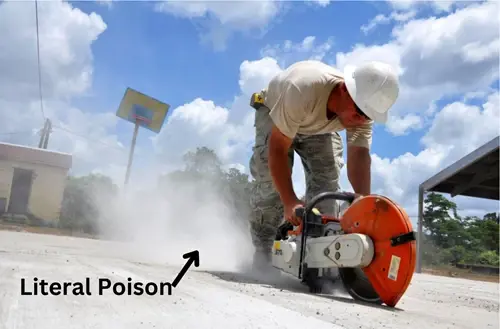Unlock Next Gen's deep dive on dust
25 April 2023
You probably know dust as the greyish blue sediment whose sole purpose is to make you reconsider just how much you need that thing you lost under the fridge. A persistent, velvety reminder that no matter how good a clean you’ve done, the call of the void comes for us all. However, that decaying detritus of dead flesh and fibres is not the star of today's show, because we’re talking about a far more pernicious particulate: silica dust.
What even is silica you ask?
Well… quartz, essentially. The white, frosted looking stones. Sand, rocks, bricks, and cement all feature silica as one of their most abundant ingredients and 99% of the time silica just wants to be left alone to do its thing, not hurting anyone, maybe even forming the occasional sandcastle. But sometimes silica gets a little bit spicy. You see, silica has quite the Napoleon complex and when it gets small enough its sole purpose is to hurt the world as much as the world hurt it. It does this because the crystalline structure of silica allows it to be stable at small sizes. So small in fact, it can form a micronized dust about 5 microns across - for reference, that’s 5 mitochondria (the powerhouse of the cell) - when exposed to enough force or abrasion. This dust is so small it can be inhaled into the lungs and trapped in the alveoli (little pockets in your lungs), with repeated exposure often resulting in the incurable and potentially fatal condition of silicosis.
How can something so small be so dangerous?
It’s precisely because they are so small that they are dangerous. We’re great at dealing with slightly bigger particles because we developed mucus membranes, internal hair, and manifold other disgusting biological features to keep them at bay. Very rarely are such small particles found in nature, so our bodies have never had any evolutionary pressure to develop a defence for them. As a result, what are now known as nanoparticles can bypass almost every line of defence you have and make a beeline for your brain or heart, hitting green lights the whole way.
To make matters even worse, it only takes a little dust to cause a lot of problems. The current UK legal limit for expose is 0.1mg/m3 of working area. To put this into perspective picture a bathtub, how much dust would you have to drop into that bathtub to exceed legal limits? A tablespoon? A pinch? Not even close. One twentieth of a milligram for your standard bathtub. That’s about the weight of an eyelash. Fortunately, exposure levels have dropped considerably with increased awareness, and the typical construction worker is now being exposed to less than the legal limit of 0.1mg/m3 when averaged across a working day.

However, statistics paint with broad brushes. What they don’t account for is specific trades such as bricklayers, demolitionists, and stonemasons, who are all thought to be regularly exposed to levels exceeding 0.1mg/m3. This goes some way towards explaining the estimated 900 annual lung cancer cases caused by silica dust exposure in the construction or construction materials sector, despite workplace exposure regulations.
Those 900 lung cancer cases have resulted in calls for increased regulation regarding exposure levels. No Time to Lose – a campaign by the Institute of Occupational Safety and Health – estimate that as many as 300 of these cases could be prevented through tighter regulations. However, experts have highlighted the issue of poor awareness and resulting lack of compliance with rules regarding personal protective equipment. To this end, No Time to Lose highlight that as many as 800 of the 900 lung cancer cases each year could be prevented simply through compliance with existing regulations.
This serves to highlight the importance of awareness on this issue. All too many people consider the inert to be innocuous, the tales of asbestos and chlorofluorocarbons are all we need to look at to remind ourselves of this. And make no mistake, this is not an issue consigned to tradesmen.
The smaller the dust particle, the more dangerous it is to your lungs as we’ve already covered. Worryingly, the smaller the dust particle, the further it can travel in the air and closer it gets to our homes where, unlike our place of work, we spend most of our time. This increased time spent exposed means safe maximum levels drop even lower. Fortunately, silica dust concentration is a monitored metric by regulators and is taken seriously, though current trends of increasing construction in high-density areas and required demolitions may prove a cause for concern in the future.
You won’t make many friends espousing the danger of dust, but less than 5% of those with a lung cancer diagnosis live to see another decade. If the cost of human life is vigilance, we’d be missing out on the deal of a literal lifetime.
If you’d like to know more about the team behind Unlock Next Gen, join the conversation on our podcast, or contribute to our blog, get in touch at hello@unlocknextgen.co.uk , Twitter or LinkedIn – we’d love to hear from you!

